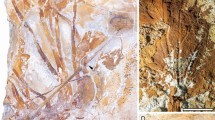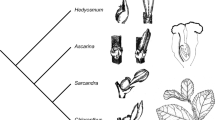Abstract
Fossils have played a central role in our understanding of the evolution of conifers. Interpretation of the seed cone as a compound strobilus and the homologies of the ovuliferous scales of modern conifers with the axillary dwarf shoot of Pennsylvanian forms are based on fossils. Similarly, early evolutionary trends involving the reduction, fusion, and planation of the fertile and sterile elements of the axillary dwarf shoot, leading to structures characteristic of modern families, are documented in Late Permian and Triassic conifers. However, a phylogeny elucidating the derivation of modern families from fossil forms based on shared derived features has been elusive.
The present cladistic treatment using 11 characters of ovulate cones and one of pollen grains suggests three phylogenetic groups of Late Paleozoic conifers, represented loosely by the Emporicaceae, Utrechtiaceae, and Majonicaceae of Mapes and Rothwell. The Taxaceae appears to have diverged from ancestors within the Utrechtiaceae, whereas the other modern families owe their origins to the Majonicaceae. The origin of the Taxodiaceae appears to have been biphyletic.Taxodium, Cupressus andSciadopitys are strongly linked toDolmitia of the Majonicaceae, butCryptomeria, Cunninghamia andAraucaria are grouped together and diverge basal to the former taxa.Pinus branches from a position basal to the known genera of the Majonicaceae and all modern families except the Taxaceae.Podocarpus also diverges basal toMajonica but may share an ancestor with this genus;Cepahalotaxus diverges basal to theDolmitiaPseudovoltzia subclade but distal toMajonica. Similarly, the Cheirolepidiaceae originated from basal members of the Majonicaceae and shows no close phylogenetic relationship with any modern family. Except for a strong linkage betweenCycadocarpidium and theAraucariaCunninghamia subclade, genera of the Voltziaceae appear to have branched more or less independently from within the Majonicaceae and show no strong affinity with modern conifers. Thus differences between modern conifer families are due mainly to their divergence from different Paleozoic ancestors.
Similar content being viewed by others
Literature Cited
Aase, H. C. 1915. Vascular anatomy of the megasporophylls of conifers. Bot. Gaz. 60: 277–313.
Archangelsky, S. &R. Cuneo. 1987. Ferugliocladaceae, a new conifer family from the Permian of Gondwana. Rev. Palaeobot. & Palynol. 51: 3–30.
Arnold, C. A. 1947. An introduction to paleobotany. McGraw-Hill, New York.
Axsmith, B. J. &T. N. Taylor. 1997. The Triassic conifer seed coneGlyptoletpis. Rev. Palaeobot. & Palynol. 96: 71–79.
Beck, C. B. 1981.Archaeopteris and its role in vascular plant evolution. Pp. 193–223in K. J. Niklas (ed.), Paleobotany, paleoecology, and evolution, vol. 1. Praeger, New York.
Bock, W. 1954.Primaraucaria, a new araucarian genus from the Virginia Triassic. J. Paleontol. 28: 32–42.
Brunsfeld, S. J., P. S. Soltis, D. E. Soltis, P. A. Gadek &C. J. Quinn. 1994. Phylogenetic relationships among the genera of the Taxodiaceae and Cupressaceae: Evidence from rbcL sequences. Syst. Bot. 19: 253–262.
Calder, M. 1953. A coniferous petrified forest in Patagonia. Bull. Brit. Mus. (Nat. Hist.) Geol. 2: 97–138.
Clement-Westerhof, J. A. 1984. Aspects of Permian palaeobotany and palynology. IV. The coniferOrtiseia Florin from the Val Gardena Formation of the Dolomites and the Vicentinian Alps (Italy) with special reference to a revised concept of the Walchiaceae (Goppert) Schimper. Rev. Palaeobot. & Palynol. 41:51–166.
—. 1987. Aspects of Permian palaeobotany and palynology. VII. The Majonicaceae, a new family of Late Permian conifers. Rev. Palaeobot. & Palynol. 52: 375–402.
—. 1988. Morphology and phylogeny of Paleozoic conifers. Pp. 298–337in C. B. Beck (ed.), Origin and evolution of gymnosperms. Columbia University Press, New York.
Crane, P. R. 1985. Phylogenetic analysis of seed plants and the origin of angiosperms. Ann. Missouri Bot. Gard. 72: 716–793.
—. 1988. Major clades and relationships in “higher” gymnosperms. Pp. 218–272in C. B. Beck (ed.), Origin and evolution of gymnosperms. Columbia University Press, New York.
Cuneo, R. 1985. Ejemplares fertiles deGenoites patagonica Fergulio (Buriadiaceae, Coniferopsida?) del Permico de Chubut, República Argentina. Ameghiniana 22: 269–279.
De Laubenfels, D. J. 1953. The external morphology of coniferous leaves. Phytomorphology 3: 1–20.
Delevoryas, T. D. &R. C. Hope. 1987. Further observations on the Late Triassic conifersCompsostrobus neotericus andVoltzia andrewsii. Rev. Palaeobot. & Palynol. 51: 59–64.
Doyle, J. A. &M. J. Donoghue. 1986. Seed plant phylogeny and the origin of angiosperms: An experimental cladistic approach. Bot. Rev. (Lancaster) 52: 321–431.
Eckenwalder, J. E. 1976. Re-evaluation of Cupressaceae and Taxodiaceae: A proposed merger. Madroño 23: 237–256.
Florin, R. 1938-1945. Die Koniferen des Oberkarbons und des Unteren Perms. Palaeontographica, Abt. B, 85: 1–729.
—. 1948. On the morphology and relationships of the Taxaceae. Bot. Gaz. 110: 31–39.
—. 1951. Evolution in cordaites and conifers. Acta Horti Berg. 15: 285–388.
—. 1954. The female reproductive organs of conifers and taxads. Biol. Rev. 29: 367–389.
—. 1958. On Jurassic taxads and conifers from northwestern Europe and eastern Greenland. Acta Horti Berg. 17: 257–402.
Galtier, J., A. C. Scott, J. H. Powell, B. W. Glover &C. N. Waters. 1992. Anatomically preserved conifer-like stems from the Upper Carboniferous of England. Proc. Roy. Soc. London B 247: 211–214.
Grauvogel-Starnm, L. 1978. La flore du Grès a Voltzia (Bundsandstein supérieur) des Vosges du Nord (France): Morphologie, anatomie, interprétations phylogenetique, et palèogeographique. Univ. Louis Pasteur de Strasbourg, Inst. Géol. 50: 1–225.
Harris, T. M. 1935. The fossil flora of Scoresby Sound, East Greenland, Pt. 4: Ginkgoales, Coniferales, Lycopodiales and isolated fructifications. Meddel. Gronland 112: 1–176.
—. 1943. The fossil coniferElatides williamsoni. Ann. Bot., n.s. 7: 325–339.
—. 1953. Conifers of the Taxodiaceae from the Wealden Formation of Belgium. Mem. Inst. Roy. Sci. Nat. Belgium 126: 1–43.
—. 1979. The Yorkshire Jurassic Flora. V. Coniferales. British Museum (Natural History), London.
Hart, J. A. 1987. A cladistic analysis of conifers: Preliminary results. J. Arnold Arbor. 68: 269–307.
Jung, W. W. 1968.Hirmerellia muensteri (Schenk) Jung nov. comb., eine bedeutsame Konifere des Mesozoikums. Palaeontographica B, 122: 55–93.
Kerp, J. H. F. &J. A. Clement-Westerhof. 1991. Aspects of Permian palaeobotany and palynology. XII. The form-genusWalchiostrobus Florin reconsidered. N. Jahrb. Geol. Palaont. Abh. 183: 257–268.
—,R. Poort, H. Swinkels &R. Verwer. 1989. A conifer dominated flora from the Rotliegend of Oberhausen (Saar-Nahe-Area). Courier Forschungsinst. Senckenberg 109: 137–151.
———. 1990. Aspects of Permian palaeobotany and palynology. IX. Coniferdominated Rotliegend floras from the Saar Nahe Basin (?Late Carboniferous-Early Permian; SW Germany) with special reference to the reproductive biology of early conifers. Rev. Palaeobot. & Palynol. 62: 205–248.
Mapes, G. 1987. Ovule inversion in the earliest conifers. Amer. J. Bot. 74: 1205–1210.
— &G. W. Rothwell. 1984. Permineralized ovulate cones ofLebachia from Late Palaeozoic limestones of Kansas. Palaeontology 27: 69–94.
——. 1988. Diversity among Hamilton conifers. Pp. 225–244in G. Mapes & R. H. Mapes (eds.), Regional geology and paleontology of upper Paleozoic Hamilton quarry area in southeastern Kansas. Guidebook 6, Kansas Geological Survey, Lawrence.
——. 1991. Structure and relationships of primitive conifers. N. Jahrb. Geol. Palaont. Abh. 183:269–287.
—— &M. T. Haworth. 1989. Evolution of seed dormancy. Nature 337: 645–646.
Miller, C. N., Jr. 1975. Petrified cones and needle-bearing twigs of a new taxodiaceous conifer from the Early Cretaceous of California. Amer. J. Bot. 62: 706–713.
—. 1977. Mesozoic conifers. Bot. Rev. (Lancaster) 43: 217–280.
—. 1982. Current status of Paleozoic and Mesozoic conifers. Rev. Palaeobot. & Palynol. 37:99–144.
—. 1988. The origin of modern conifer families. Pp. 448–486in C. B. Beck (ed.), Origin and evolution of gymnosperms. Columbia University Press, New York.
—. 1990. Stems and leaves ofCunninghamiostrobus goedertii from the Oligocene of Washington. Amer. J. Bot. 77:963–971.
— &J. T. Brown. 1973. A new voltzialean cone bearing seeds with embryos from the Permian of Texas. Amer. J. Bot. 60: 561–569.
— &C. A. LaPasha. 1983. Structure and affinities ofAthrotaxites berryi Bell, an Early Cretaceous conifer. Amer. J. Bot. 70: 772–779.
Nixon, K. C., W. L. Crepet, D. Stevenson &E. M. Friis. 1994. A reevaluation of seed plant phylogeny. Ann. Missouri Bot. Gard. 81: 484–533.
Ogura, Y. 1930. On the structure and affinities of some Cretaceous plants from Hokkaido. J. Fac. Sci. Univ. Tokyo, Sect. 3, Bot. 2: 381–412.
Ohana, T. &T. Kimura. 1995. Further observations ofCunninghamiostrobus yubariensis Stopes and Fujii from the Upper Yezo Group (Upper Cretaceous), Hokkaido, Japan. Trans. Proc. Palaeont. Soc. Japan, n.s. 178: 122–141.
Pant, D. D. 1982. The Lower Gondwana gymnosperms and their relationships. Rev. Palaeobot. & Palynol. 37: 55–70.
— &D. D. Nautiyal. 1967. On the structure ofBuriadia heterophylla (Feistmantel) Se ward & Sahni and its fructifications. Philos. Trans. Roy. Soc. London 252B: 27–48.
Parris, K. M., A. N. Drinnan &D. J. Cantrill. 1995.Palissya cones from the Mesozoic of Australia and New Zealand. Alcheringa 19: 87–111.
Price, R. A. &J. M. Lowenstein. 1989. An immunological comparison of the Sciadopityaceae, Taxodiaceae, and Cupressaceae. Syst. Bot. 14: 141–149.
—,J. Thomas, S. H. Strauss, P. A. Gadek, C. J. Quinn &J. D. Palmer. 1993. Familial relationships of the conifers from rbcL sequence data. Amer. J. Bot. 80: 172.
Roselt, G. 1958. Neue Koniferen aus dem unteren Keuper und ihre Besiehungen zu verwandten fossilen und rezenten. Wiss. Z. Friedrich-Schiller-Univ. Jena, Jahrg. 5: 75–118.
Rothwell, G. W. 1982.Cordaianthus duquesnensis sp. nov., anatomically preserved ovulate cones from the Upper Pennsylvanian of Ohio. Amer. J. Bot. 69: 239–247.
—. 1988. Cordaitales. Pp. 273–297in C. B. Beck (ed.), Origin and evolution of Gymnosperms. Columbia University Press, New York.
— &R. Serbet. 1994. Lignophyte phylogeny and the evolution of spermatophytes: A numerical cladistic analysis. Syst. Bot. 19: 443–482.
Schweitzer, H.-J. 1963. Der weibliche Zapfen vonPseudovoltzia liebeana und seine Bedeutung für die Phylogenie der Koniferen. Palaeontographica B, 113: 1–29. 75–118.
—. 1996.Voltzia hexagona (Bischoff) Geinitz aus dem Mittleren Perm Westdeutschlands. Palaeontographica B, 239: 1–22.
— &M. Kirchner. 1996. Die Rhäto-Jurassichen Floren des Iran und Afghanistans: 9. Coniferophyta. Palaeontographica B, 238: 77–139.
Scott, A. C. 1974. The earliest conifer. Nature 251: 707–708.
— &W. G. Chaloner. 1983. The earliest fossil conifer from the Westphalian B of Yorkshire. Proc. Roy. Soc. London B 220: 163–266.
Singh, H. 1961. The life history and systematic position ofCephalotaxus drupacea Sieb, et Aucc. Phytomorphology 11: 153–197.
Stewart, W. N. &G. W. Rothwell. 1993. Paleobotany and the evolution of plants. Ed. 2. Cambridge University Press, New York.
Stockey, R. A. 1975. Seeds and embryos ofAraucaria mirabilis. Amer. J. Bot. 62: 856–868.
—. 1977. Reproductive biology of the Cerro Cuadrado (Jurassic) fossil conifers:Pararaucaria patagonica. Amer. J. Bot. 64: 733–744.
—. 1978. Reproductive biology of Cerro Cuadrado fossil conifers: Ontogeny and reproductive strategies inAraucaria mirabilis (Spegazzini) Windhausen. Palaeontographica B: 166: 1–15.
—. 1982. The Araucariaceae: An evolutionary perspective. Rev. Palaeobot. & Palynol. 37: 133–154.
—. 1990. Antarctic and Gondwana conifers. Pp. 179–191inT. N. Taylor & E. L. Taylor (eds.), Arctic paleobiology. Springer-Verlag, New York.
Swofford, D. 1993. PAUP: Phylogenetic analysis using parsimony, version 3.1.1. Computer program distributed by the Illinois Natural History Survey, Champaign.
Taylor, T. N. &E. L. Taylor. 1993. The biology and evolution of fossil plants. Prentice Hall, Englewood Cliffs, NJ.
Thomas, B. A. &R. A. Spicer. 1987. The evolution and palaeobiology of land plants. Croom Helm, London.
Townrow, J. A. 1967a. OnRissikia andMataia, podocarpaceous conifers from the Lower Mesozoic of southern lands. Pap. & Proc. Roy. Soc. Tasmania 101: 103–136.
—. 1967b. OnVoltziopsis, a southern conifer of Lower Triassic age. Pap. & Proc. Roy. Soc. Tasmania 101: 173–188.
Trivett, M. L. &G. W. Rothwell. 1991. Diversity among Paleozoic Cordaitales. N. Jahrb. Geol. Palaont. Abh. 183:289–305.
Watson, J. 1988. The Cheirolepidiaceae. Pp. 383–447in C. B. Beck (ed.), Origin and evolution of gymnosperms. Columbia University Press, New York.
White, M. E. 1981. The cones ofWalkomiella australis (Fiest.) Florin. Palaeobotanist 28-29: 75–80.
Yao, X., T. N. Taylor &E. L. Taylor. 1993. The Triassic seed coneTelemachus from Antarctica. Rev. Palaeobot. & Palynol. 78: 269–276.
Author information
Authors and Affiliations
Rights and permissions
About this article
Cite this article
Miller, C.N. Implications of fossil conifers for the phylogenetic relationships of living families. Bot. Rev 65, 239–277 (1999). https://doi.org/10.1007/BF02857631
Issue Date:
DOI: https://doi.org/10.1007/BF02857631




